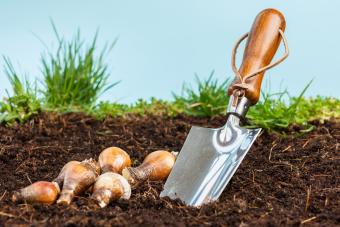
Most people plan to plant veggies during the spring, but there are flowering bulbs you can also put in the ground in the early months of the year. Planting spring bulbs might not have made your to-do list in years past, but it's something you can easily tack on. Planting spring bulbs takes just a few steps and a little know-how, so anyone with a desire to have beautiful summer blooms can learn the best spring planting techniques.
Planting Bulbs in the Fall vs. Spring
According to the University of Illinois, bulbs are "underground, fleshy storage structures," aka they're the little oval bits that can fit into the palm of your hand that you plant in the ground. Most bulbs are perennials, meaning they go through a cycle of blooming and dormancy every year. Yet, the specific bulbs you pick will determine when you get to see those beautiful flowers.
For laypeople, the term spring bulb can be confusing. Do they bloom in the spring or do you plant them in it? Trick question - people use the term interchangeably, but there are distinctions.
Spring bulbs are plants you put in the ground in the fall and expect to bloom in the spring. These are hardy bulbs because they can withstand the colder weather. Meanwhile, summer bulbs are the plants you put in the ground in spring and will get to see bloom in late summer. Naturally, these bulbs can't handle the cold temperatures as well as spring bulbs can.
When Should I Plant Bulbs in the Spring?

Summer bulbs that you're planting in the spring shouldn't be buried in the dirt until the ground is pretty warm, there's no chance of frost, and the soil has an average temperate of 60°F. Cold soil and weather can rot your bulbs before they have a chance to take root.
If you're eager to get your bulbs in the ground as soon as possible, you can pot them inside about a month before it's safe to plant outside. Then, all you have to do is transfer your rooted bulbs to their permanent home.
How Do I Plant Bulbs in the Spring?
Once the soil and temperature reach the right conditions, you can start the planting process for your summer bulbs.
- Pick out the bulbs that you want to plant as well as some compost or other organic material since they thrive in soil mixed with it.
- Designate a well-drained area to plant your bulbs.
- Mix the soil with compost and organic material to ready it for planting.
- Using a trowel, dig holes about 2-3x bigger than the size of the bulbs, and drop your bulbs in.
- Cover them with soil, and lightly water them.
How Much Should I Water Them?
How much you water spring-planted bulbs depends on what plants you're growing. Each plant has different needs. For instance, elephant ears like moisture, but other bulbs can rot if they're over watered. When it comes to watering, follow the standard recommendations for each of the different plants you grow.
How Long Does It Take for Them to Sprout and Bloom?
Bulbs that you plant in the spring won't be ready to bloom until later-summer or early fall. If you're looking for plants that'll bloom during springtime, plant bulbs in the fall instead.
How Do I Care for Them During Winter?
Bulbs that you plant in the spring can't be left in the ground during the winter because they're too fragile. Instead, you have to dig them up and store them in a safe place. You can read more about how to dig up your bulbs safely here.
What Kinds of Bulbs Can You Plant in the Spring?

The flowers that immediately come to mind when you think of spring aren't the bulbs you'll be planting during the season. These fickler plants are less popular, and get less attention, despite being beautiful.
If you're thinking about planting bulbs this spring, here are a few options to choose from:
- Dahlia
- Elephant ear
- Calla lily
- Begonia
- Iris
- Oriental lily
Work Off Those Winter Blues by Gardening
For people with a green thumb who get re-energized by working outside, the winter months are a treacherous time. We know you'll jump at any excuse to get back into your overalls and dirty gardening gloves. Look no further than planting bulbs in the spring as soon as the weather turns. They'll let you flex your gardening skills again and prepare your yard for some beautiful summer blooms.







